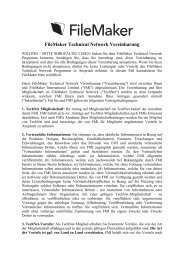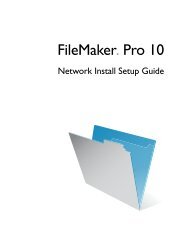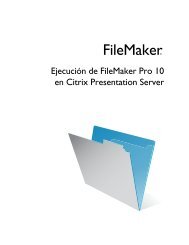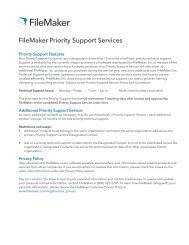FileMaker Server Guide to Updating Plug-ins
FileMaker Server Guide to Updating Plug-ins
FileMaker Server Guide to Updating Plug-ins
Create successful ePaper yourself
Turn your PDF publications into a flip-book with our unique Google optimized e-Paper software.
Chapter 1 | Preparing Mac OS plug-<strong>ins</strong> with resource forks for Au<strong>to</strong> Update 9<br />
Preparing Mac OS plug-<strong>ins</strong> with resource forks for Au<strong>to</strong> Update<br />
<strong>FileMaker</strong> <strong>Server</strong> on Mac OS temporarily converts an uncompressed Mac OS plug-in <strong>to</strong> the .tar format for<br />
downloading <strong>to</strong> clients. However, this au<strong>to</strong>matic conversion deletes any resource forks, which may make a<br />
plug-in that contained a resource fork unusable by the client.<br />
Mac OS plug-in files that contain a resource fork require special actions <strong>to</strong> work properly with Au<strong>to</strong> Update:<br />
1 The plug-in must be manually compressed before being placed on <strong>FileMaker</strong> <strong>Server</strong>.<br />
1 Any Mac OS <strong>FileMaker</strong> Pro client using Au<strong>to</strong> Update with this plug-in must have StuffIt Expander<br />
<strong>ins</strong>talled <strong>to</strong> au<strong>to</strong>matically decompress the plug-in.<br />
To manually compress a plug-in containing a resource fork:<br />
1. Use a third-party utility like StuffIt Standard <strong>to</strong> manually compress the entire Mac OS plug-in in<strong>to</strong> a<br />
single file such as a .sitx archive. You can use any utility that compresses files with resource forks, as<br />
long as the output file can be au<strong>to</strong>matically decompressed by StuffIt Expander.<br />
2. Rename the compressed file with the .sitx or other extension <strong>to</strong> end with .tar. For example, if the plug-in<br />
was named test.fmplugin, and the compressed file is named test.fmplugin.sitx, that<br />
compressed file must be renamed <strong>to</strong> test.fmplugin.tar.<br />
3. Place the compressed plug-in on the server computer in the appropriate folder. See “Where <strong>to</strong> s<strong>to</strong>re plug<strong>ins</strong><br />
on <strong>FileMaker</strong> <strong>Server</strong>” on page 9.<br />
Important StuffIt Expander must be <strong>ins</strong>talled on the Mac OS client computer <strong>to</strong> expand the specially<br />
compressed plug-in. Au<strong>to</strong> Update au<strong>to</strong>matically calls StuffIt Expander after downloading the plug-in.<br />
Where <strong>to</strong> s<strong>to</strong>re plug-<strong>ins</strong> on <strong>FileMaker</strong> <strong>Server</strong><br />
You must s<strong>to</strong>re plug-<strong>ins</strong> in the following folders on a server:<br />
Au<strong>to</strong>Update folder<br />
<strong>Plug</strong>-in parent folder<br />
The plug-in parent folder<br />
must have the same name<br />
as the plug-in<br />
Subfolder containing the plug-in file<br />
Overview of the plug-in folder structure<br />
The subfolder containing the<br />
plug-in must have the same<br />
name as the plug-in version<br />
number<br />
<strong>Plug</strong>-in
















